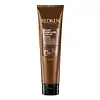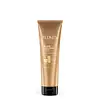What's inside
What's inside
 Key Ingredients
Key Ingredients

No key ingredients
 Benefits
Benefits

 Concerns
Concerns

 Ingredients Side-by-side
Ingredients Side-by-side

Water
Skin ConditioningCetearyl Alcohol
EmollientBehentrimonium Chloride
PreservativeCetyl Esters
EmollientAmodimethicone
Parfum
MaskingSodium Benzoate
MaskingIsopropyl Alcohol
SolventCitric Acid
BufferingPlukenetia Volubilis Seed Oil
EmollientEthylhexyl Methoxycinnamate
UV AbsorberCetrimonium Chloride
AntimicrobialBenzyl Alcohol
PerfumingCoumarin
PerfumingLinalool
PerfumingBenzyl Benzoate
AntimicrobialAloe Barbadensis Leaf Juice Powder
Skin ConditioningHexyl Cinnamal
PerfumingLimonene
PerfumingCitronellol
PerfumingAmyl Cinnamal
PerfumingGeraniol
PerfumingCitral
PerfumingCereus Grandiflorus Flower Extract
Skin ConditioningAlpha-Isomethyl Ionone
PerfumingGlucose
HumectantLactic Acid
BufferingPotassium Sorbate
PreservativeTocopherol
AntioxidantWater, Cetearyl Alcohol, Behentrimonium Chloride, Cetyl Esters, Amodimethicone, Parfum, Sodium Benzoate, Isopropyl Alcohol, Citric Acid, Plukenetia Volubilis Seed Oil, Ethylhexyl Methoxycinnamate, Cetrimonium Chloride, Benzyl Alcohol, Coumarin, Linalool, Benzyl Benzoate, Aloe Barbadensis Leaf Juice Powder, Hexyl Cinnamal, Limonene, Citronellol, Amyl Cinnamal, Geraniol, Citral, Cereus Grandiflorus Flower Extract, Alpha-Isomethyl Ionone, Glucose, Lactic Acid, Potassium Sorbate, Tocopherol
Water
Skin ConditioningCetearyl Alcohol
EmollientBehentrimonium Chloride
PreservativeAmodimethicone
Glycerin
HumectantOctyldodecanol
EmollientIsopropyl Alcohol
SolventPhenoxyethanol
PreservativeCaprylyl Glycol
EmollientParfum
MaskingSodium PCA
HumectantBenzoic Acid
MaskingTrideceth-6
EmulsifyingCetrimonium Chloride
AntimicrobialCitric Acid
BufferingArgania Spinosa Kernel Oil
EmollientArginine
MaskingHydrolyzed Soy Protein
HumectantHydrolyzed Vegetable Protein Pg-Propyl Silanetriol
Skin ConditioningWater, Cetearyl Alcohol, Behentrimonium Chloride, Amodimethicone, Glycerin, Octyldodecanol, Isopropyl Alcohol, Phenoxyethanol, Caprylyl Glycol, Parfum, Sodium PCA, Benzoic Acid, Trideceth-6, Cetrimonium Chloride, Citric Acid, Argania Spinosa Kernel Oil, Arginine, Hydrolyzed Soy Protein, Hydrolyzed Vegetable Protein Pg-Propyl Silanetriol
 Reviews
Reviews

Ingredients Explained
These ingredients are found in both products.
Ingredients higher up in an ingredient list are typically present in a larger amount.
This water-soluble silicone is used for its hydrating and softening properties. It is used to add a silky feel to skincare products and has great benefits for haircare.
In haircare, this ingredient:
- Adds shine
- Protects color
- Offers thermal protection
- Boosts hair strength
- Does not build up as easily
This ingredient is a preservative and often used for it's anti-static properties. You'll most likely see this ingredient in hair conditioners.
It does not cause irritation or sensitization in leave-on products at 1-5%.
Cetearyl alcohol is a mixture of two fatty alcohols: cetyl alcohol and stearyl alcohol. It is mainly used as an emulsifier. Emulsifiers help prevent the separation of oils and products. Due to its composition, it can also be used to thicken a product or help create foam.
Cetearyl alcohol is an emollient. Emollients help soothe and hydrate the skin by trapping moisture.
Studies show Cetearyl alcohol is non-toxic and non-irritating. The FDA allows products labeled "alcohol-free" to have fatty alcohols.
This ingredient is usually derived from plant oils such as palm, vegetable, or coconut oils. There is debate on whether this ingredient will cause acne.
Due to the fatty acid base, this ingredient may not be Malassezia folliculitis safe.
Learn more about Cetearyl AlcoholThis ingredient is a preservative, antimicrobial, and emulsifier. It is often used in cosmetics for its ability to cleanse, condition, and reduce static.
Cetrimonium chloride is a quaternary ammonium salt, meaning it has a water-soluble structure.
Citric Acid is an alpha hydroxy acid (AHA) naturally found in citrus fruits like oranges, lemons, and limes.
Like other AHAs, citric acid can exfoliate skin by breaking down the bonds that hold dead skin cells together. This helps reveal smoother and brighter skin underneath.
However, this exfoliating effect only happens at high concentrations (20%) which can be hard to find in cosmetic products.
Due to this, citric acid is usually included in small amounts as a pH adjuster. This helps keep products slightly more acidic and compatible with skin's natural pH.
In skincare formulas, citric acid can:
While it can provide some skin benefits, research shows lactic acid and glycolic acid are generally more effective and less irritating exfoliants.
Most citric acid used in skincare today is made by fermenting sugars (usually from molasses). This synthetic version is identical to the natural citrus form but easier to stabilize and use in formulations.
Read more about some other popular AHA's here:
Learn more about Citric AcidIsopropyl Alcohol is more commonly known as rubbing alcohol. It is most commonly used as a solvent, meaning it helps other ingredients dissolve.
This ingredient is an astringent alcohol. Astringent alcohols may also irritate skin as they high amounts may strip away your skin's natural oils.
Other types of astringent alcohols include:
According to the National Rosacea Society based in the US, you should be mindful of products with these alcohols in the top half of ingredients.
Any type of sanitizing product will have high amounts of alcohol to help kill bacteria and viruses.
Learn more about Isopropyl AlcoholParfum is a catch-all term for an ingredient or more that is used to give a scent to products.
Also called "fragrance", this ingredient can be a blend of hundreds of chemicals or plant oils. This means every product with "fragrance" or "parfum" in the ingredients list is a different mixture.
For instance, Habanolide is a proprietary trade name for a specific aroma chemical. When used as a fragrance ingredient in cosmetics, most aroma chemicals fall under the broad labeling category of “FRAGRANCE” or “PARFUM” according to EU and US regulations.
The term 'parfum' or 'fragrance' is not regulated in many countries. In many cases, it is up to the brand to define this term.
For instance, many brands choose to label themselves as "fragrance-free" because they are not using synthetic fragrances. However, their products may still contain ingredients such as essential oils that are considered a fragrance by INCI standards.
One example is Calendula flower extract. Calendula is an essential oil that still imparts a scent or 'fragrance'.
Depending on the blend, the ingredients in the mixture can cause allergies and sensitivities on the skin. Some ingredients that are known EU allergens include linalool and citronellol.
Parfum can also be used to mask or cover an unpleasant scent.
The bottom line is: not all fragrances/parfum/ingredients are created equally. If you are worried about fragrances, we recommend taking a closer look at an ingredient. And of course, we always recommend speaking with a professional.
Learn more about ParfumWater. It's the most common cosmetic ingredient of all. You'll usually see it at the top of ingredient lists, meaning that it makes up the largest part of the product.
So why is it so popular? Water most often acts as a solvent - this means that it helps dissolve other ingredients into the formulation.
You'll also recognize water as that liquid we all need to stay alive. If you see this, drink a glass of water. Stay hydrated!
Learn more about Water